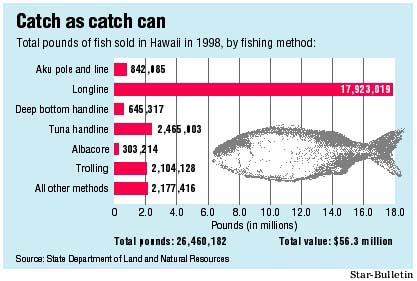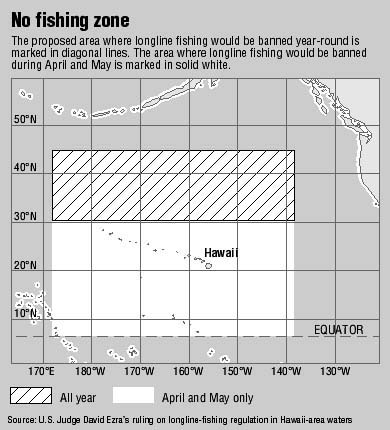Advertisement - Click to support our sponsors.

Fisheries observers
ask for time
and money
Rep. Mink seeks funding as a judge
delays his order for an observer
on every longline boat
in HawaiiJudge will be asked to reconsider
By Peter Wagner
Star-BulletinA judge's order requiring full monitoring of longline fishing boats in Hawaii will put hard-pressed federal fisheries regulators to the test.
"We're struggling with how to deal with this," said Charles Karnella, Pacific area administrator of the National Marine Fisheries Service. "To my knowledge, this would be the biggest effort with observers the agency has ever been involved with in a single fishery."
U.S. District Judge David Ezra on Friday ordered the Fisheries Service to provide trained observers for all of the approximately 115 long-line fishing boats in Hawaii within 30 days. The agency's current staff of four observers research threats to endangered sea turtles by keeping data on what the long-liners catch, keep and toss back.

An environmental impact statement on the interaction of long-liners -- whose hooks are said to kill hundreds of turtles in the Pacific each year -- is due by the agency next April.Ezra yesterday modified his order, allowing an extension of up to six months to comply with his order of "100 percent coverage."
But Ezra stuck to his demand that all boats carry an observer, a dilemma for the cash-strapped Fisheries Service which since 1994 has overseen the long-line observer program in Hawaii.
Struggling with a $500,000 deficit, the program since May has cut its staff from 14 to four observers.
U.S. Rep. Patsy Mink yesterday announced passage of a $1.2 million budget amendment to save the struggling program. Mink said the money would hire at least 25 observers.
"It is critical that we both protect these endangered species and ensure the survival of the Hawaii-based fishing industry," she said.
A similar bill in a Senate committee sets $1.5 million aside to revive the observer program. Mink hopes either measure will make money available by the time the environmental study is completed next year.
Jim Cook, administrator of the Western Pacific Regional Fishery Management Council, estimated it would cost $10 million a year to put a trained observer on each boat in the longline fleet.
Fearing the cost could fall to the fishermen, the Hawaii Longline Association yesterday met to discuss the possibility of appealing Ezra's ruling.
The association's directors were meeting this morning to make decisions and a general membership meeting was scheduled at 1:30 p.m. today at the United Fishing Agency.
Although Ezra modified his order, Cook said it "essentially closes down 95 percent of the Hawaii longline fishery, which is to say it closes down 100 percent, really."
Targeting tuna and swordfish, Hawaii's $50 million longline fishing industry is part of a $165 million fishing industry that includes wholesalers, retailers and suppliers.
Karnella yesterday said a staff of 20 to 30 observers is enough to gather the necessary data. He questioned the need for 115 observers.
"If the purpose of placing these observers is to collect information, then scientifically it would be overkill," he said.

Mink similarly questioned the need for so many observers.But finding even a modest staff for the task ahead poses both budgetary and practical problems for fisheries service' small office in Honolulu , Karnella said.
He noted that it takes up to five months to recruit and train new observers.
The process involves advertising, screening, processing through regional offices, a month's training, and a physical examination. The observer program itself has no base funding, Karnella said, relying instead on spotty allocations from other programs within the agency.
Another problem facing the agency in its new task is the lack of office space for even a modestly expanded staff, Karnella said.
Ezra in his order yesterday acknowledged the federal agency's budgetary problems but blamed it for not protecting the endangered turtles.
"It was National Marine Fisheries Service's noncompliance with the National Environmental Policy Act that caused the current situation," he wrote.
"Accordingly, the (fisheries service) must comply with (the act) in an expeditious manner so as to avoid undue burden on the Hawaii Longline Association and minimize damage to the turtle species."
Meanwhile, the Fisheries Service is trying to determine how many vessels in Hawaii's fleet are in use at a given time.
That determination could reduce the number of observers needed for full compliance, Karnella said.
Longlingers to ask
By Peter Wagner
judge to reconsider,
may appeal ruling
Star-BulletinThe Hawaii Longline Association announced plans today to petition a federal judge to reconsider a ruling that bans longline fishing in waters surrounding Hawaii and requires a trained observer on all boats to protect endangered sea turtles.
"We can't afford to just sit back and accept the ruling," said Sean Martin, president of the association, which represents about 115 longline fishing boats.
Martin said the association may also appeal U.S. District Judge David Ezra's ruling.
Martin said Ezra's ruling also restricts the number of fishing lines the boats can set in the restricted area. Longline vessels last year deployed about 12,000 fishing lines. Ezra's ruling cuts that to 636. He said next year's allotment will be exhausted by early March, 2001 -- a month before an environmental impact statement by the National Marine Fisheries Service is due under the court's order.
Without a softening of the judge's order, Martin said, Hawaii's longline fleet will likely disperse to other ports.